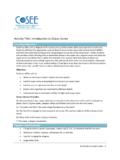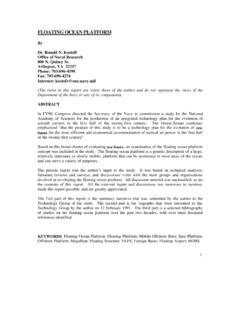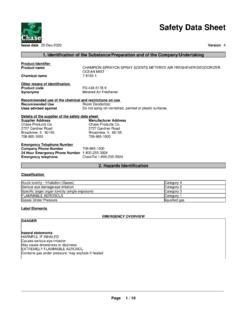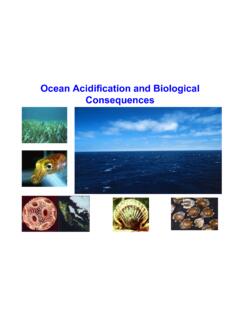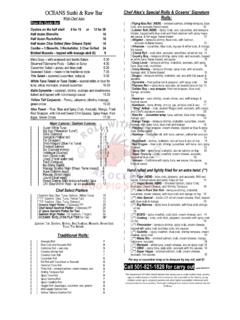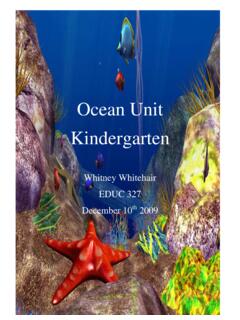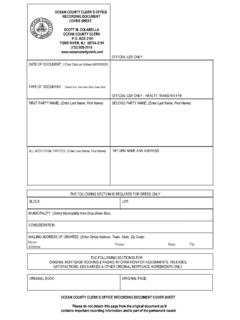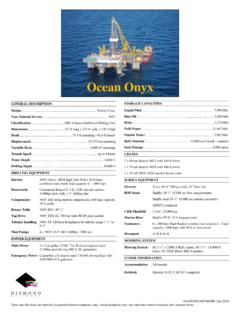Transcription of Understanding Ocean Acidification
1 Understanding Ocean AcidificationPrior KnowledgeThis curriculum module is designed for students who are taking high school chemistry. Students should already have some experience with thefollowing: Understanding and reading the pH scale. Knowledge of the carbon cycle. Using scientific notation to express large and small values. Reading chemical equations. Table of ContentsThe Basics of Ocean the Education 1: Measuring Ocean 2: The Ocean -Carbon 3: The Oceans & Carbonate 4: Aragonite Saturation & Marine 5: Design Your Own May 2011 This curriculum module was developed for the NOAA Ocean Data Education (NODE) Project by Caroline Joyce, Todd Viola and Andrew Amster in collaboration withthe NOAA Coral Reef Conservation Program ( ) and the National Oceanographic Data Center. This project has been made possible with support of the National Marine Sanctuary and technical advice was provided by Dr. Joseph Salisbury, Assistant Research Professor at theUniversity of New is hereby granted for the reproduction of this lesson without alteration and on the condition that the acknowledgment above is lessons at increasing levels of sophistication incorporate real data from NOAA to help students understand the phenomenon of Ocean Level: 10 12 Aligned to National Standardsin Mathematics and Science, Ocean Literacy Essential Principles, Climate Literacy Essential Principles and selected state standards.
2 See page Basics of Ocean AcidificationBurning fossil fuels releases carbon dioxide into Earth s atmosphere. This not only leads to a warmer Earth ( , global warming, the greenhouse effect), but also changes the chemistry of Earth s oceans. The Ocean is a carbon sink, which means that it removes CO2 from the atmosphere. The Ocean currently absorbs about one-third of the CO2 released by the burning of fossil fuels. However, beyond a certain level of atmospheric CO2, the Ocean can no longer act as a carbon sink withoutit having a negative impact on marine life. When CO2 dissolves in seawater, it leads to decreased pH levels. The Ocean becomes less alkaline. This is referred to as Ocean Acidification . As the Ocean water becomes less alkaline, there is a resulting decrease in the amount of carbonate ions available for many marine organisms to form their calcium carbonate hard parts. Coral polyps are less able to precipitate the mineral aragonite, which they use to build or rebuild their skeletons.
3 This means that a coral reef might stop growing and become more vulnerable to erosion. Other marine organisms, such as oysters, might also be Ocean Acidification is important for citizens engaged in debating global climate change issues, policies, and solutions. If Understanding Ocean Acidification2 Web LinksFor links to helpful websites about Ocean Acidification , visit CO2 levels continue to rise, coral reefs may disappear from all of Earth s oceans by OverviewThis curriculum incorporates a scaled approach to learning. Each moduleoffers activities at five different levels of student interaction, sometimes referred to as Entry, Adoption, Adaptation, Interactivity, and Invention. The early levels are very directed and teacher-driven, which provides important first steps when learning something new. The levels of Adaptation through Invention are more student-directed and open up opportunities to design lessons featuring student levels serve a dual purpose.
4 They are designed to engage students inincreasingly sophisticated modes of Understanding and manipulating data. They are also intended to help you, as a teacher, familiarize yourself with online tools for accessing data and to provide you with models for integrating the use of real data into your classroom chart below illustrates the five levels of this module, Understanding Ocean Acidification . 1 For more information about the research behind this approach, consult these papers: Dwyer, D. C., Ringstaff, C., & Sandholtz, J. H. (1990). Teacher beliefs and practices, Part I: Pattern of change. ACOT Report # 8. Cupertino, CA: Apple Classroom of Tomorrow Advanced Technology Group, Apple Computer, , , Goin, L., Hasselbring, , Kinzer, , Sherwood, , & Williams, (1999). Learning with technology: Theoretical and empirical perspectives. Peabody Journal of Education. Ocean Acidification3 Scaled Levels5 Invention4 Interactivity3 Adaptation2 Adoption1 Entry5 Invention: Design Your Own Investigation: Students will design an investigation using real dataon conditions in the Caribbean study area.
5 Students will use this real data to try to answer a research question of their choosing. 4 Interactivity: Aragonite Saturation & Marine Calcifiers: Students will use online data to support or disprove a simple hypothesis about increased atmospheric CO2 and the health of marine calcifiers, such as coral : Carbonate Buffering System: Students will use online tools to recreate climate change model scenarios and examine effects of increased CO2 on Ocean acidity and carbonate saturation : The Ocean -Carbon Connection: Students will use data graphs of Ocean pH, sea-surface temperature, and CO2 data to find the driving factor behind Ocean : Measuring Ocean pH: Students will examine data maps and graphs to look for patterns and relationships that would explain variationsin Ocean levels provide a natural opportunity for you to adapt and customize the curriculum module as needed. For example, if students already have experience with the topic, you may find that you can skip the entry level Ocean Acidification4 Using the TechnologyTeaching using technology presents some challenges.
6 Because this curriculum demonstrates strategies for using real scientific data availableon the Internet, it assumes that you and your students will have access to the Internet at some point during the investigation. Because the level and availability of Internet access varies widely from setting to setting, however, you may need to adapt the activities to suit your particular situation. To help you, the activities are designed with flexibility in example: When access to real data is needed, the Preparation section describes steps that can be performed outside of class. Data and results can be saved for use in class. Data can be accessed through the Web site using special forms that have been designed for this project. While it is recommended that you familiarize yourself with how to access data using these tools, the early lessons also contain blackline masters of important maps, graphs, and other data products, which can be used in settings where live Internet access is not available.
7 An important outcome of these activities, especially at the higherlevels, is for students to learn how to access and manipulate data themselves. In the ideal case, students will access the Internet individually or in groups in order to generate maps and graphs using real data. In settings where this is not possible, the curriculum provides student masters, which can be reproduced and used in class. To fully explore the questions posed in the highest level activities, however, students in these settings will need to access the Internet in a library or computer center outsideof Ocean Acidification5 Next Generation Science StandardsAll NODE modules follow guiding principles found in the Next Generation Science Standards (NGSS)2. The standards are based on the notion of learning as a developmental progression. The activities in this module can be incorporated into an existing curriculum or unit of study to help address NGSS principles, core ideas, and concepts for grades 9-12.
8 A guide to this module s connections with NGSS can be found by visiting the Ocean Acidification section of the website, under Downloads. Ocean Literacy Essential Principles The Ocean is a major influence on weather and climate. The Ocean has had, and will continue to have, a significant influence on climate change byabsorbing, storing, and moving heat, carbon and water. Ocean habitats are defined by environmental factors. Due to interactions of abiotic factors such as salinity, temperature, oxygen, pH, light, nutrients, pressure, substrate and circulation, Ocean life is not evenly distributed temporally or spatially. Humans affect the Ocean in a variety of ways. Human development and activity leads to pollution (point source, non-point source, and noise pollution).Climate Literacy Principles The abundance of greenhouse gases in the atmosphere is controlled by biogeochemical cycles that continually move these components between their Ocean , land, life, and atmosphere reservoirs.
9 The chemistry of Ocean water is changed by absorption of carbon dioxide from the atmosphere. Increasing carbon dioxide levels in the atmosphereis causing Ocean water to become more acidic, threatening the survival of shell-building marine species and the entire food web. Environmental observations are the foundation for Understanding the climate system. From the bottom of the Ocean to the surface of the Sun, instruments on weather stations, buoys, satellites, and other platforms collect climate NGSS Lead States. 2013. Next Generation Science Standards: For States, By States. Washington : The National Academies Press. Next Generation Science Standards is a registered trademark of Achieve. Neither Achieve nor the lead states and partners that developed the Next Generation Science Standards was involved in the production of, and does not endorse, this Ocean Acidification6 Level 1: EntryMeasuring Ocean pHObjectives Students will learn how to use online tools to access false-color data maps and graphs of Ocean pH data.
10 Students will examine data maps and graphs to look for patterns and relationships that would explain variations in Ocean students should be familiar with measuring the pH of solutions in the laboratory. pH is the measure of the hydrogen ion concentration in a solution. pH is used to express acidity or alkalinity on a scale of 0 to 14. Less than 7 represents acidity, 7 is neutral, and greater than 7 is alkaline. This illustration shows the pH values of common solutions:pH is measured on a logarithmic scale, where small changes have increasingly greater effects. A solution with a pH of 3 is ten times more acidified than a solution with a pH of 4 and 100 times more acidified than solution with a pH of 5. Earth s oceans are naturally slightly alkaline. The pH of surface seawateris around Ocean Acidification refers to the observed, ongoing processby which the pH in Earth s oceans is gradually decreasing, with the resultthat the water is becoming less alkaline.

